The CES 2024 has just closed its doors, and it was a «good vintage» according to its organizers with 135,000 visitors (+4% vs. 2023, see review from last year) from 150 countries, 4,300 exhibitors (including 1,400 startups), and 250 conferences including some Keynotes bringing their share of renowned CEOs or even stars (Eva Longoria made a notable appearance at L’Oréal’s Keynote).
In addition, CTA, the organization behind the Consumer Electronics Show, celebrated its 100th anniversary, creating additional peripheral events for its members.
This year’s main themes were AI, sustainable development, inclusion, but also health & well-being and mobility with a strong presence in the automotive sector; In recent years, the industry has indeed appropriated the CES to present technologies and future concepts, and the presence of Geely, Polestar, Fisker, Hyundai, Kia, Mercedes-Benz, BMW and Chinese manufacturers has been noted; On the other hand, there was the relevant absence of General Motors, Ford and Stellantis, partially due to the economic impact of the 2023 strikes in the United States.
And unsurprisingly Artificial Intelligence was everywhere, but finally not the inept flood I had expected. Of course, the word was in all the mouths and on most of the stands and displays, but in a reasoned way; Exhibiting companies often integrate AI bricks while staying focused on their core business.
On the other hand, the term «Metaverse» had almost disappeared from the descriptions, even if we could see the term «Industrial Metaverse», which includes the XR, the digital twins, but also the AI and the IoT, at the heart of the Siemens Keynote; or more entertainment-oriented Metaverse like the Caliverse, «hyper-realistic metaverse» which announced a partnership with Tomorrowland.
Finally, the French Tech confirmed its interest in the CES 2024 exhibition, highlighting 135 French startups, with this year a particular focus on «SportTech» (Olympic Games 2024 oblige).
XR, not just solutions but now an international ecosystem
Companies working on immersive technologies were as many as last year, if not more, but more fragmented in the different sites/halls, which made the identification (and visits) exercise more complex.
Based on the classification of the CES 2024 xhibitor database, 337 companies were categorized in the directory as part of the AR/VR/XR/METAVERSE sector, representing 8% of exhibitors, but the scope of the profiles was very wide: XR solution and content providers from all sectors, manufacturers of glasses/optics/lenses but also companies from the world of haptics, audio and (more recently) olfactory.
Also worth noticing, the strong presence of Asia on the XR sector: if the largest number of exhibitors came from the United States (91), South Koreans (86!) and Chinese (60) were widely represented. The next country was France with 18 exhibitors, then Japan with 8 companies, and that stood for the top 5 of this CES 2024 edition.
XR Industry Trends: Automotive, Sport and Disability
There were a few pure XR software providers on the CES, though much less than I would have liked. Truth is, this show remains a good platform if you want to (1) highlight a very innovative and differentiating solution (and with a bit of luck get an Award), (2) deploy on the US market and test your product or (3) create international partnerships (such as BavARt that signed an MOU with Korea); otherwise the cost of participating to the CES 2024 remains quite expensive.
Segment-wise, the automotive industry was present in most of the CES stands, either through concept cars, technical innovations, or mobility solutions.
The good news is that XR starts being well represented in the projects of manufacturers and suppliers of automotive solutions. A particularly interesting trend is that our technologies can support the industry’s efforts to maximize the use of sensors in vehicles; Valéo presented an application in VR/MR, which thanks to the use of cameras inside and outside the car, creates visual experiences integrating the flow of cameras, but also gesture control.
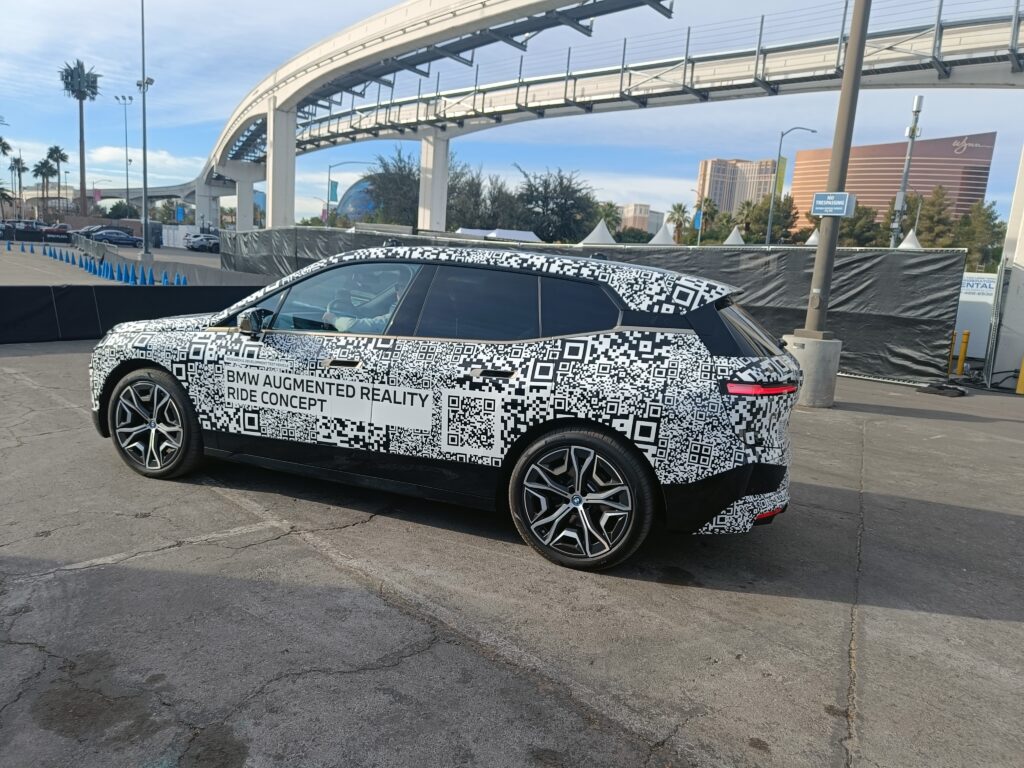
BMW also uses sensors and cameras, but in the perspective of serving future owners of AR glasses, who could connect to the vehicle, and drive with information that appears in the field of vision (driver) or get entertainment contents (passengers). The excellent demonstration performed on the XREAL air2pro, already shows how the solution could be eventually hardware agnostic, being simply triggered by the sue of sensors & a dedicated software.
The use of XR can also result in the integration of new technologies such as the “AR windshield”; For example, Eyelights demonstrated its latest windshield where the dashboard information is displayed for the driver, and infotainment for the passenger.
Projects that reveal the large scope of future opportunities between XR solutions and the vehicles of tomorrow.
The other segment full of new entrants was sport. Approaching captive users, fans of an activity and ready to pay for their favorite hobby is indeed an interesting target. Therefore Oostlong developed glasses for skiers thanks to a former ski professional, who was able to drive the right specifications, the right uses, but also the right marketing. Everysight focuses on cyclists, with 42g goggles at $399 that can be ordered on their website. As for the Solos glasses they have no screen but allow athletes to interact with the system connected to the smartphone via BT to listen to music or answer the phone.
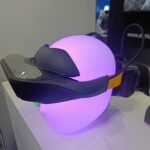
Finally, a trend that is not new but is now confirmed, is the use of glasses for accessibility. Xander was again at CES 2024 with its devices for the hearing impaired, and Lumen will launch at the end of 2024 in Europe a pair of glasses for the visually impaired, which with its 6 cameras, its IMU and its 90fps, would replace the dogs of the blind by offering the same features/ gestures. Other manufacturers will enter the market in the coming years, in a niche where there is a strong need, targeted use and an opportunity to work together with public and private medical insurances to ease access to products.
Connected glasses, a sector in full turmoil.
As always, faithful to its historic line of conduct and despite the upcoming release of the Vision Pro (February 2nd in the United States), Apple was the big absent from the show. Meta, Microsoft and Rokid have also given up.
Magic Leap demonstrated its now well-known ML2 in a suite, and Lynx was present on the Ultraleap booth whose technology is natively present in the helmet.
The major surprise (at least for me) was the announcement of a Sony mixed reality headset at the Siemens Keynote. They jointly developed a product aiming at visualizing 3D renderings from the CAC tools of the German group for designers & engineers with a collaborative mode. A product with high-end specifications with 4k screens and the latest generation of Qualcomm XR2 Gen2 chip, also announced at CES 2024. A long-awaited foray by Sony into the XR professional segment, albeit historically focused on consumers, from Glasstron in 1996 (!) to PlayStation VR headsets.
On the augmented reality/secondary display products front, there is a real offer being built with more brands that are positioning themselves in the market; so many that I missed a few in the immensity of the show floor! Even brands like Sharp presented a product simply called Sharp XR and launched this year only in Japan.

In notable points, Xreal presented its various products on its large and bright stand: Air2, Air2pro and especially Air2 Ultra, their new model. Still connected to a phone (but only the latest Samsung Galaxy S for now), the 80gr product now has two 6DoF front cameras/sensors to map the environment and be able to use gesture control (no photos nor videos). Nice product in titanium finish, the resolution is the same as the Air2 (already good) and the field of view changes to 52 degrees (better); the demonstration of gesture control was not very convincing, but it will have to be retested on a final product and in better conditions. Still a nice little product, and especially it is a good strategy to add little by little features without harming the spirit of the range. The product is pre-order for developers at €799.
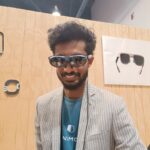
Right next door was the stand of Tom Thumb Nimo, embodied by its popular founder Rohildev, friendly and accessible to all visitors. The product is interesting, with a slightly different positioning than its famous neighbor, as the intelligence is embedded in a tiny case, itself compatible with other glasses (including XREAL). The set is comfortable to wear with good specifications: 128GB memory, 8GB flash, 3H battery, 50deg field of view, Snapdragon XR2, BT and WIFI. The use case is clearly virtual office with multiplying screens to envy and interchangeable in a smooth way. The product is open for pre-orders at $399, available in 6 to 8 months.
As for TCL, they presented their range, with an addition of a new RayNeo X2 Lite, but difficult to have a demonstration this time outside the booth, not very conclusive. The specifications are interesting: 60gr, 1500nit of brightness, Qualcomm Snapdragon AR1 Gen1 chip, wireless connectivity, 3 hours of battery…. It will have to be assessed when the product is available in Europe (no date for now).
The surprise came from a new actor from Shenzhen with an unlikely name, NRMYW, which presented a product on a very stylish, beautiful stand: a pair of binocular glasses with transparent lenses, in standalone version. Everything is integrated in this design, a bit bulky but very acceptable for a first model: no need for a phone, intelligence is embedded in this product of… 100gr! The specifications are at the level: 8 core processor chip, 60 degrees of field of view, 128Gb of storage and 16Gb of RAM. They made an interesting choice: a TV-style remote control with a Qwerty keyboard on the back. The test shot has some flaws (low resolution (840*640) and low brightness (700nits)), but the direction is particularly good. A player to follow.
Finally, the tireless brand Vuzix announced on its stand a new product with the Z100, a secondary display type of glass weighing 36gr, connectable in Bluetooth, single color display (but eventually in color), 48h of battery life, $799 in the developer version from February 2024 in Europe. A new segment for Vuzix, which must find the right use cases.
Accessories for XR: haptic tools, controllers, and olfactory solutions at the forefront
What struck me first about haptic accessories is the number of companies that are now positioned in the gloves segment. In addition to the companies already known as HaptiX, which continue their progress in terms of reducing the size of the solution, newcomers with technological alternatives were present at CES 2024.
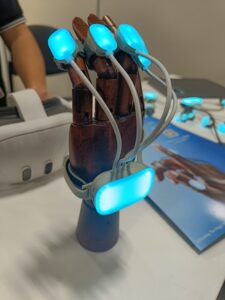
PalmPlug for example, chooses to complete the haptic sensations with coloured LEDs on the gloves, based on the assumption that the sense of viewing reacts faster than the sense of feeling, and are both useful.
Finally in the remarkable products, the Japanese start-up Kurimoto, which uses a black fluid reacting to electrical impulses to create a so-called «passive» haptic system. The targets are the game at first, then the industrial world.
We could also see that the overall smartglasses market is growing, because companies are being created around navigation and UX, creating more intuitive controllers, and more oriented «hands-free solutions».
Aavaa for example, specializes in brain-computer interface technologies and deploys products that analyse and interpret eye and face movements to produce an action, offering a hands-free solution for connected glasses.
DoublePoint‘s controls any device via a Bluetooth connection of a connected watch; the watch becomes the epicentre of all BT objects management, including IoT, smart home products or connected glasses for example.
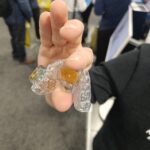
But in this category, the product that surprised me the most is undoubtedly the «mouthwear» from Augmental, an accessory that looks like a mouthpiece, full of electronics and which, via a Bluetooth connection, allows to remotely control an interface with the tongue. I obviously could not assess it, but if it proves stable, I already perceive interesting use cases for this technology!
Finally, a new trend that I noticed at CES 2024 is the presence of companies focusing on olfactory, with the goal of adding odors to user experiences.
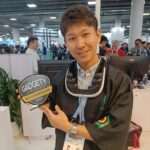
In this context, Aromajoin created quite spectacular scent diffusers, which look like very design red speakers, to emit odours in «static» version. The most interesting, however, is their «collar» holding up to 6 capsules that allows to send odours in conjunction with a video from an AR/VR headset for example. The product is launched in crowdfunding in May 2024.
Iromascents is also positioned in this market, with a round case of about twenty centimetres in diameter, connected to a platform that allows editing a film to send the smells at specific times. 45 refillable chambers are present in the case, based on liquids (and not solid scents like most competitors). They have developed an offer for Retail to be able to overcome the problems of thefts, by offering the possibility of testing perfumes without making the bottles available. Iromascents does not have a portable or embeddable product on their roadmap for now.
Other companies presented olfactory solutions, and there is a clear development of new proposals answering real problems. But the show closed its doors and after 4 days of wanderings, I surrendered!
The next CES is already planned for next year, from January 7 to 10, 2025 in Las Vegas. (NB: And car lovers can follow next year with the newly scheduled Detroit Auto Show from January 10 to 20, 2025!!!!)
